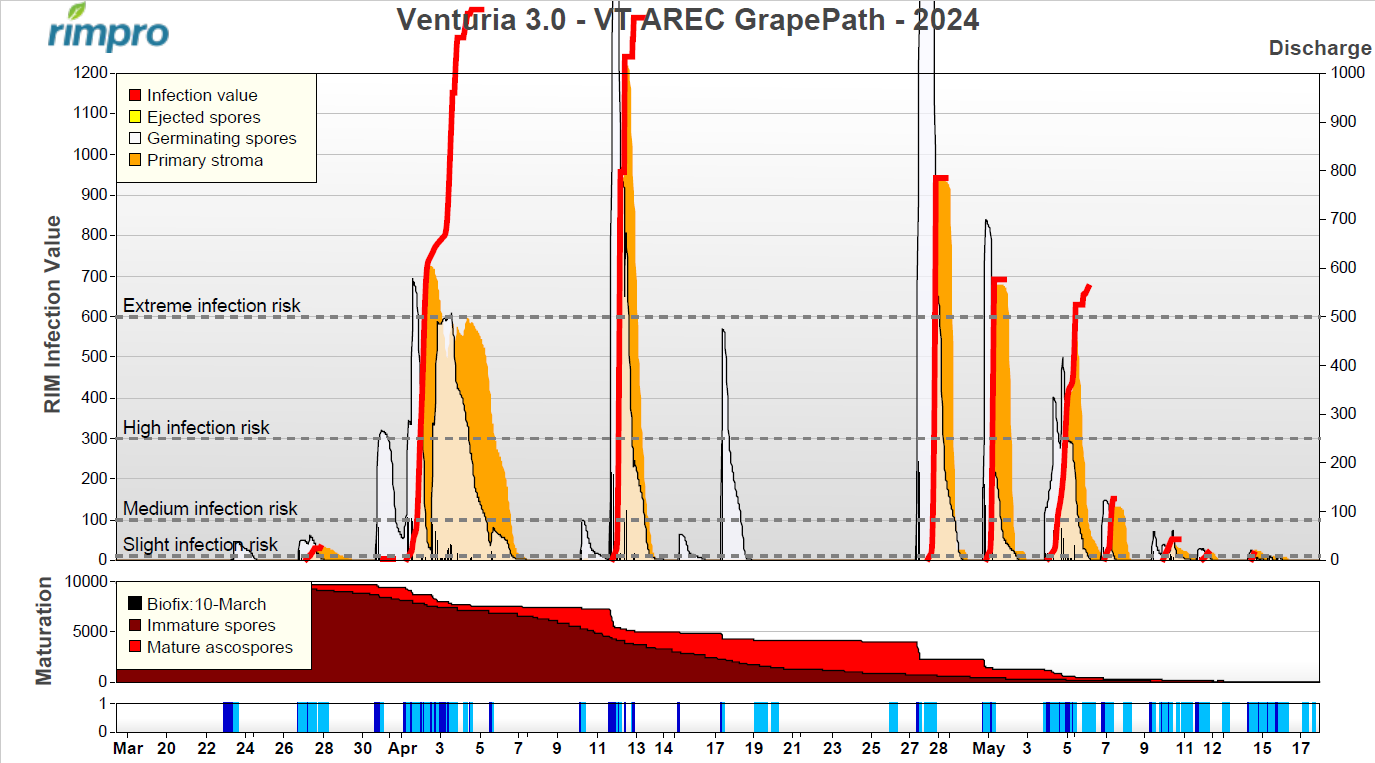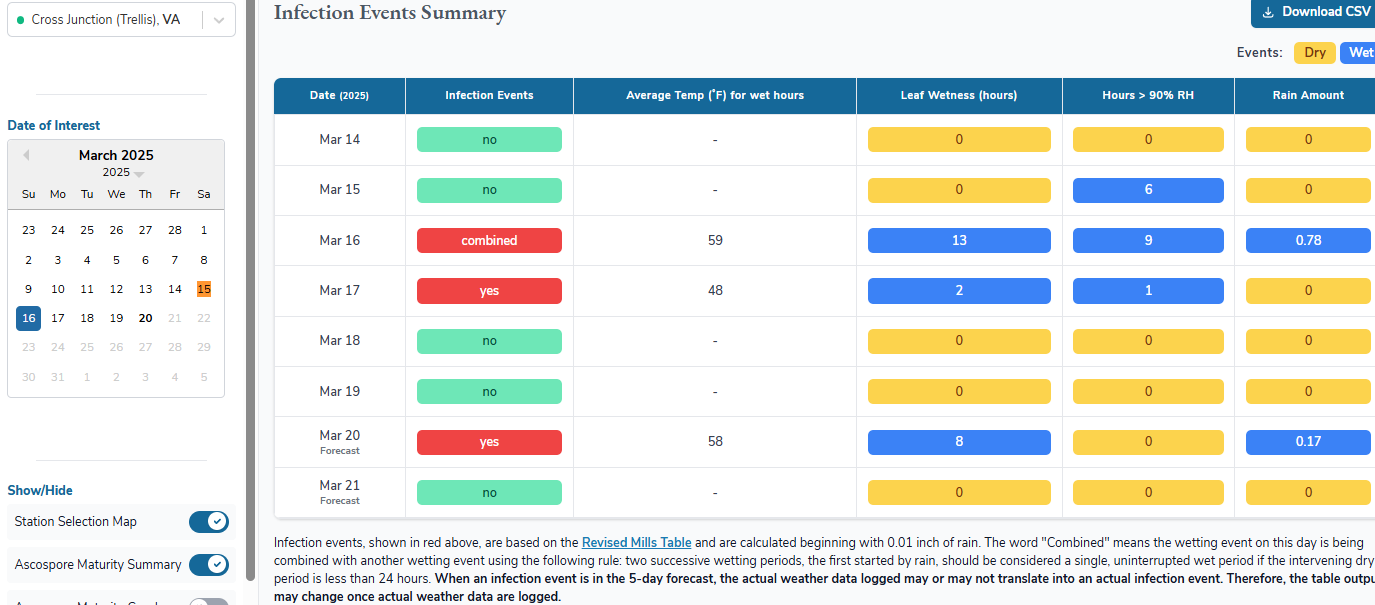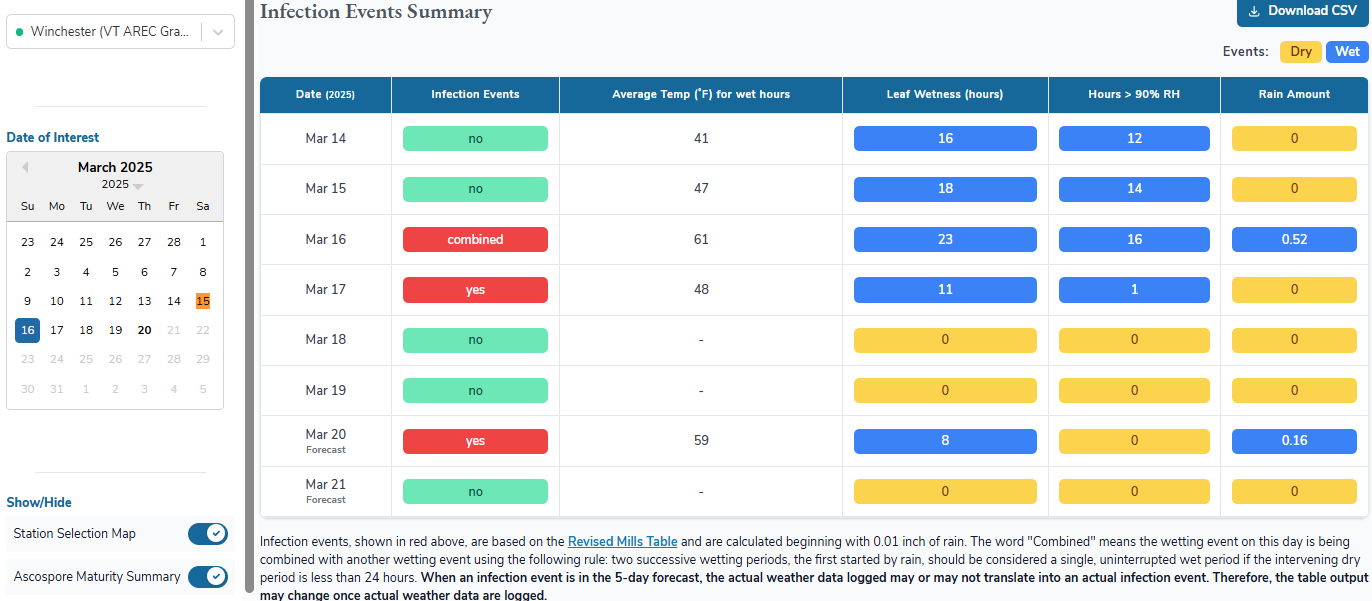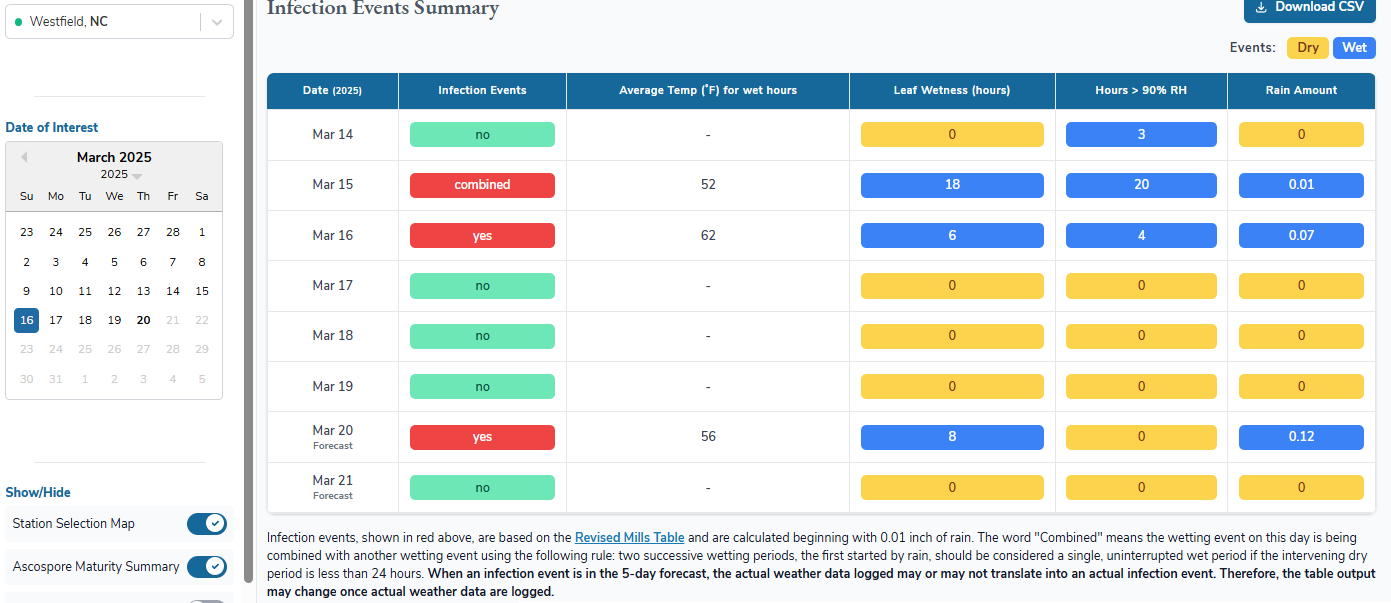Delayed Dormant Copper, When to Apply It and Should you Add Oil or Not?
A standard recommendation for delayed dormant copper is applying it on apples between Silver Tip and until but NOT beyond quarter inch green tip (QIG), by looking at the floral apple buds (these are wider in appearance and on spurs; leaf buds are pointy and narrow instead). Looking at the a floral buds, QIG is an apple growth stage which ensues when 50% of floral buds are open and visibly expressing the stage QIG. Applying the copper after 50% QIG stage is a risk for bud injury and fruit russetting later on. If you decide to risk it and to apply copper at the 1/2-inch Green Tip (HIG) i.e. later than QIG, you should definitely see first if the label allows this growth stage use, and if yes, then use the so called “softer” formulations like Cueva, or use much lower equivalent metallic copper rate per acre of your copper material of choice. There is a risk from many factors to allow copper to injure buds or cause fruit skin rusetting later:
– Did you read the copper pesticide label and checked if HIG stage is allowed for application of that specific material? Which rate? If not, do not use it at this stage.
– Did you count the buds in a sample of 100 randomly chosen buds walking through the orchard and tallied buds in 5 categories: Dormant, Silver Tip, GT, QIG, HIG, and did your tally show 50% of buds HIG? If you are anywhere beyond 50% of buds at HIG, you risk an injury by copper. Do not use it, if you were late to spray.
– Did you fix your sprayer on time and got it calibrated i.e. up and running before the window between Silver Tip and QIG? If you did, go for it, but if not, do not risk to apply the copper material not labeled for HIG stage use just because your tractor or sprayer was not ready on time.
– Did you look at the ruts in the orchard, is it muddy from last week’s rain? Or the oncoming weather forecast shows we will have days with slow drying conditions? Be tactical: muddy midrows might delay you to apply copper pushing you to do it beyond QIG risking bud injury, or if slow drying conditions are oncoming based on weatehr forecast, reconsider applying copper, choose lower rate, or use less injurious formulation of the copper.
We just do not recommend applying copper beyond QIG as we do not know what weather conditions we will have ahead. Even very low rates of copper are risky in slow drying conditions which can can cause copper to trigger fruit russetting (you wont see it now, it will be later, when fruit enlarge beyond 20 mm). If you have an orchard that had fire blight last year, you should definitely consider applying copper this year from silver tip to QIG bud stage, but you do not need to apply it necessarily, if you had no fire blight and you had no scab last year in that block. Also. do not apply copper near frost events (I hope we do not have any this spring). If you are Green Tip and up to QIG, and you want to apply delayed dormant copper, it is not advisable to apply copper and/or oil in the situations where hard frosts are announced. Anything spray-applied on the plant surface, following freezes, will get sucked into the green tissue plant cells as frost crystals melt and injure the bud tissue. Oil or copper, alone, can exacerbate frost injury, but mixing them together is potentially even more damaging to injured green tissue by frost. Although, we can’t say we have seen injury of this mix after frost, being worst than either compounds alone, it is concerning to apply this mix near a hard frost.
Now, some of you are asking me what about copper and apple scab? Ask yourself, do I have cultivars at Green Tip or not and did I see apple scab last year in my orchard? On March 16, 2025, we recorded 50% Green Tip on ‘Gala’ trees at the VT AHS Jr AREC) in Winchester, VA. Keith Yoder sent me a picture of HIG stage on apples in Carrol county on 14 March 2025, so if you are there you are already spraying. We define the Green Tip (GT) as the date at which on your earliest apple cultivar of interest, that is susceptible to scab, your trees reach 50% of fruit buds at green tip. Infection from apple scab can occur on any exposed green tissue, starting from GT, if the scab ascoposres in apple leaf litter on the on the orchard floor are mature. The best way to determine if your trees are at green tip is by randomly looking at 100 floral buds (not vegetative or terminal buds) on at least 10 or 15 trees, and tallying up in tabs of five on a piece of paper the buds in dormant, silver tip, and green tip stage categories. If you get 50 out of 100 of all buds you look are at green tip, you record that day as Green Tip stage date. The best way to predict apple scab infection using the weather forecast are the models like NEWA scab model is available here: https://newa.cornell.edu/apple-scab (free) and RIMpro model available here: https://www.rimpro.eu/ (subscription based, and not that expensive, since to connect one NEWA weather station the cost is $299 which is 250 EUR). I would warmly recommend this model as it offers opportunity to reduce fungicide applications for scab control based on my experiance.
If you had visible scab symptoms on apple leaves and/or fruit in 2024, both early or late in the season, you will need to apply fungicides starting at green tip (GT) and not skip the following applications at 5 to 7 days spray interval during the following stages: quarter inch green (QIG), half-inch green (HIG), tight cluster (TC), pink bud (PK), bloom (BL), petal fall (PF) and first cover (FC). The reason why such strict schedule is necessary is because you are starting the 2025 growing season with a high apple scab fungus spore dose in leaf litter on the orchard floor which means that the carryover infection pressure is high from the previous season. Your delayed dormant copper applied from GT to QIG is equal in efficacy to one mancozeb spray application, so no point in doing both.
Delayed dormant copper can reduce fire blight bacterium inoculum which reaches bark surface from cankers during warm weather in spring in the form of exuded orange ooze of the bacterium or as ooze-less bacterial colonies. Copper will also affect any apple scab fungal mycelium overwintering in buds. The usual rate is 6 to 8 lbs of some of the popular products like Cuprofix, COCS, NuCop (fixed coppers, 40 to 50% copper equivalent). However, if you had fire blight last year or heavy rains are predicted in spring, it is wise to use the highest labelled rate of copper for delayed-dormant use, so that some residue lasts on the tree through the rain. If fire blight was not an issue in your or any nearby orchards and you do not have fire blight cankers on your trees, you can apply mancozeb instead of copper. Keep in mind that maximum rate of copper allowed between silver-tip and green-tip stage is that of Basic Copper 53, limited to no more than 11.3 lbs of product/Acre (6.0 lbs copper/A), which might be something you can consider if you had fire blight and/or bitter rot in your orchard last year (if can help with reducing overwintering inoculum).
In 2024, the first major scab infections were recorded based on the RIMpro’s advanced apple scab prediction model on 1 April in Cross Junction, Timberville and Winchester (GT: 7 March on Fuji) (Fig. 1), 26 March in Westfield NC and Tyro (green tip around 4th March). So you have to monitor prediction models daily to determine if early scab infections are possible, especially in orchards which had visible scab symptoms last year.

Figure 1. RIMpro apple scab model infections reported in2024 for Winchester, VA (historical data from a weather station used in this view). White camel hump-like areas labelled “Germinating spores” show cumulative number of Venturia inaequalis ascospores that germinate over time and are read using the right-side vertical Y-axis scale that is labelled “Discharge”. The red curved lines are scab infections. Read each red curve’s peak RIM infection value(s) using the vertical Y-axis scale on the left-hand side of the graph labelled “RIM Infection Value”. Peak RIM value divided by 100 gives you the percentage of the total season’s ascospores that will cause infection for a given infection period (wetting event). Orange area labeled “Primary stroma” represents scab lesions that were initiated by infection from germinating spores and that are incubating in the leaf after which scab lesions will become visible. This is worth knowing because if no fungicide was applied before the infection started, some or all of the incubating infections can be eliminated by using fungicides with post-infection activity. The light red area in the middle graph labeled “Maturation” is the proportion of mature ascospores that are ready for discharge with wetting events whereas the dark red area shows the proportion of immature ascospores still remaining in leaf litter on the orchard floor. The dark blue bars in the bottom graph showing wetting and dates, are the actual rain periods. The light blue bars are actual wetting periods when no rain is falling but trees are still wet after rain. Used by permission of RIMpro B.V., France.
In 2025, apple scab RIMpro model for Virginia has not yet predicted that an infection is possible. We cannot report RIMpro’s call for first scab infection publicly as this model is subscription based and the data shown on the RIMpro model personal grower account is the ownership of the subscriber and not for public sharing. However, the NEWA’s freely available apple scab model, has reported that a very weak scab infections occurred in Winchester on 15-16 March and that a weak infection is possible today i.e. 20 March in Winchester, Timberville, Tyro and Rustburg VA, as well as Westfield NC where buds are in advanced stages of development (NEWA model, Figures 2-6 below). If you will use only NEWA’s apple scab prediction model, major scab infection events are when there is >15% ascospore discharge occurred or predicted (so, if you ask me, I do not think the 15-16 March was an actual infection worth being worried about. Copper you already applied or will apply took care of it). NEWA scab model is available here: https://newa.cornell.edu/apple-scab Here are the screen shots of these weak infections I mention above in NEWA scab model:





